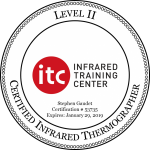For comparison I have three 65 watt rated recessed lights installed, LED, CFL and Incandescent. Using thermal imaging you can clearly see the difference on energy output and costs.
Ohms Law: Watts = amps x volts
Heat / watts is just “wasted energy”, when you use a certain amount of energy you always “produce” the same amount of heat.
| Energy Efficiency & Costs | ~68.5°F LED | ~113°F CFL | ~265°F Incandescent |
| Average Lifespan | 50,000 hours | 8,000 hours | 1,2000 hours |
| Watts of electricity used equivalent to 60w bulb(Electricity cost/yr) | 6~8 watts ($32.85/yr) brightest output of all 3 | 13~15 watts ($76.65/yr) | 60 watts ($328.59/yr) 2nd brightest of the 3 |
| Contains TOXIC Mercury | NO | YES | No |
Incandescent bulbs are due to be phased out replaced with halogen.
Halogen bulbs act most like incandescent bulbs, and have very similar energy profiles. A halogen bulb will last only about 1,000 hours and consume approximately 43 watts for the equivalent of a 60-watt incandescent light. They’re the least expensive of the non-incandescent light bulbs, available for approximately $1.25 per bulb. Their per-bulb economy has a trade-off of energy economy, as they use over two-thirds as much energy as incandescent bulbs.
Compact Fluorescent Light Bulbs (CFLs) and Mercury Mercury is an essential element in the operation of fluorescent lighting; it allows the bulbs to be an efficient light source. Because CFLs contain trace amounts of mercury, it is important to educate yourself on proper use, recycling and disposal of these products. The Facts about CFLs and Mercury
- Because CFLs use less electricity than traditional light bulbs, they reduce demand for electricity; that reduction means less greenhouse gas emissions (including less mercury) from power plants.
- CFLs contain a very small amount of mercury — an average of 4 milligrams in each bulb. Mercury is very toxic to your health and the environment.
- No mercury is released when the bulbs are intact or in use. However, Broken CFL’s are a safety hazard.
While scanning a kitchen with thermal imaging found a hot dimmer switch. Dimmer switches have a maximum wattage rating, i.e.: 6 x 65w bulbs =390 watts. If this is exceeded by installing to many bulbs or the wrong wattage we have a heat issue. In this case the recessed lighting and bulbs were properly rated for 65 watts.
The dimmer switch is operating above 100 degrees. A licensed electrician is needed to review and repair. Safe to say without thermal imaging would not be found.
One possible solution is switch all 6 bulbs over to LED’s since we know they run cooler and use less wattage.
* resource http://www.designrecycleinc.com










